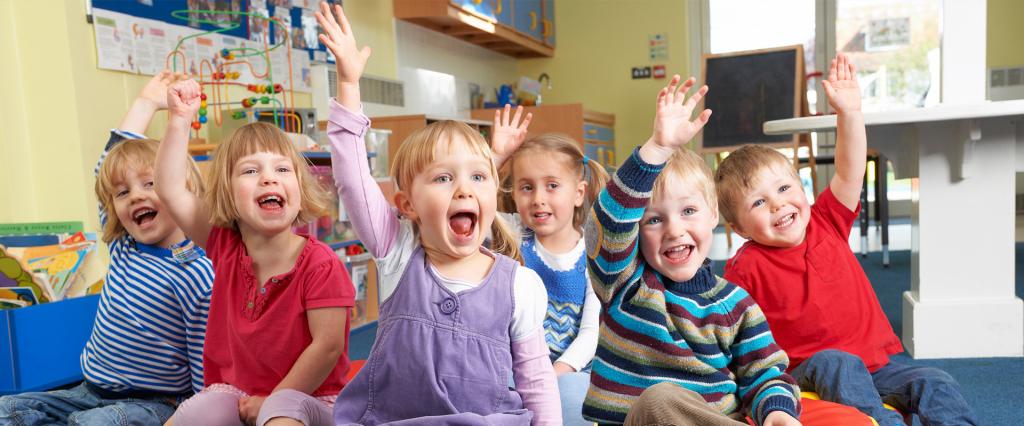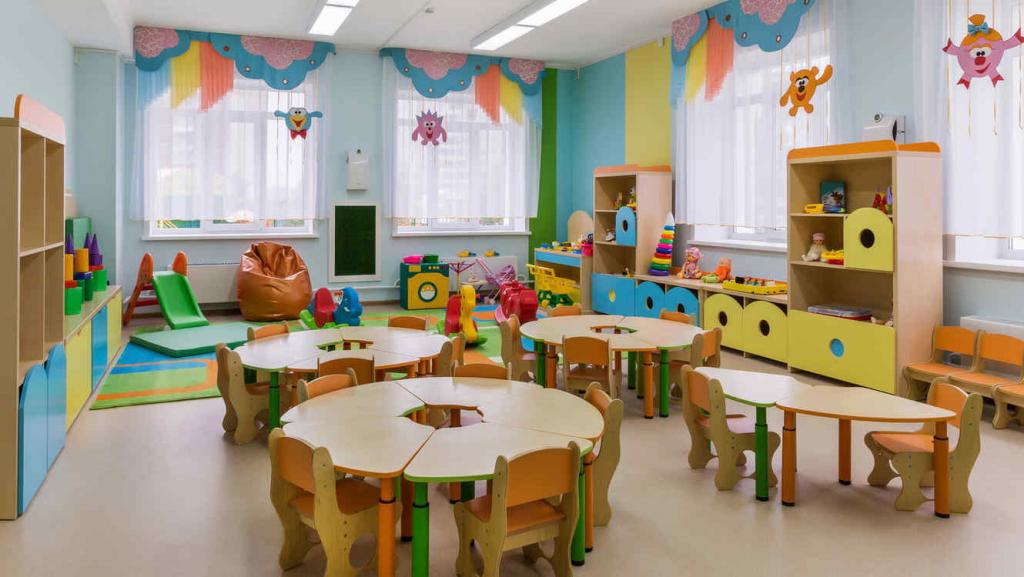A lesson in kindergarten is considered the main form of education for children, in which children learn new knowledge and consolidate previously acquired knowledge. The educator conducts a lot of preliminary work before it - prepares visual material, selects fiction, riddles or proverbs that can be used to attract the attention and interest of children. Also picks up didactic games. This is very important, as children perceive new material using their senses.
She thinks over the topic of the lesson and the form of the meeting, how to organize the children so that everyone is in the teacher’s field of vision, to distribute each part of it in time so that the children do not get tired. For this, a change of activities is used. Even if the lesson is held at the tables, then in the middle it is recommended to hold either a physical education session or play an outdoor game.
In the article, we will consider the types of classes in preschool educational institutions, what forms of organization of children are used, how to lure children so that they with pleasure accept new knowledge and do not consider classes to be hard work. We also explain for what purpose the educators analyze their activities, which gives them this form of work. You will learn what parts the classes are made of, how the educational process differs in the younger and older groups of the kindergarten.
Varieties of classes
Types of classes in DOW have several classifications. If we consider the solution of any didactic problem, then we can distinguish 4 points. These are the following types:
- learning new material when the teacher explains to children the topic planned according to the “Parenting Program”, or new practical skills are developed, for example, in modeling classes or drawing;
- consolidation of previously studied material - the repetition of a poem, learned geometric shapes or numbers, retelling of a familiar fairy tale, didactic game "Give it Right", etc .;

- classes in which children use the acquired knowledge and skills in the creative process, for example, to come up with the end of the story, make an application according to the plan on a certain topic, come up with a task for addition or subtraction, supplement the sentence, etc.
- complex - this is a combination of different types of activities for mastering one task, for example, when studying the behavior of a squirrel, the teacher suggests solving a riddle about the animal, looking at the picture, playing the game “What does the squirrel eat?”, listening to a song about this animal, and the teacher will tell you about habits a forest jumper, as she prepares for winter, will give children the task of counting the amount of nuts and mushrooms stored in the squirrel, and at the end they will suggest drawing the squirrel on their own according to the model of the educator.
Classification by knowledge content
Other types of classes in preschool education can be divided by the content of the knowledge gained. This can be a classic lesson when the guys study the planned section of the program. It can be divided into several stages:
- explanation of a new topic;
- fixing material with questions on the topic or completing a task
- summing up the work.
Another type of organization of the educational process in kindergarten is called an integrated lesson. What is this type of occupation in DOW? Consider this in the following example. For example, the educator raises the theme of "Sea." They discuss with the children the composition of sea water, transport that moves along the waves, who lives in the depths of the seas, what grows in the water, what the bottom is covered with, how people relax on the sea, what kind of entertainment happens on the water, etc.
Themes for classes at the preschool educational institution can be selected as specific, for example, a certain phenomenon of nature, a holiday or a fairy tale hero, or generalized - a store, a forest, a bakery. In the first version, children receive expanded knowledge about something specific, and in another, an understanding of the holistic picture of the work of the enterprise or store, the life of the forest, etc. is formed.
The components of the classic lesson
The structure of the lesson in the DOW is divided into 3 main parts, each of which has its own purpose.

- Preparation or organizational moment. The attention of preschool children is still hard shifting from one type of activity to another, so it takes time for the children to calm down, tune in to the lesson, concentrate on the teacher and what the teacher is talking about. This is achieved by a calm voice and the inclusion of a gaming moment, for example, a squirrel came to visit the kids and wants to tell a story that happened to her. At the same time, a bright toy appears in the teacher’s hands. It attracts the attention of children, they are already ready for the material of the lesson.
- Main part. If the initial stage lasts only a couple of minutes, then this component of the lesson is the longest, it takes from 7 to 20 minutes, depending on the age group of the kindergarten. During this time, children receive new knowledge and consolidate it in practice or through the implementation of the tasks of the teacher in oral form.
- Lesson ends with a debriefing, how to cope with the task, an analysis of children's work, if there was a visual activity. Be sure to note the active work of children and tell what they will do next.
Excursions with children
A special kind of group lessons in the preschool educational institution are excursions. This can be an organized trip to a park or to a crossroads, to a store or to a river. The tour also has a clear structure. The first part is the preparatory, which the teacher is engaged in independently. The place of excursion is chosen, who will accompany the group of children, organizational issues are resolved.
What follows is the main part - a trip with the children to the chosen place. During the tour, observation is conducted, children are asked questions, and the chosen topic is discussed. The teacher uses verbal didactic games. You can organize the collection of natural material for further crafts.
After returning to the territory of the preschool institution, what is seen is consolidated. This can be a simple conversation, an exchange of impressions or a reflection of what was seen in the drawings, the production of an album with a herbarium.
Collective viewing
To improve the skills of conducting educational activities, one of the forms of working with teachers in kindergarten is open classes. Spend them on a schedule on certain days. A manager or a methodologist, a group of educators from other groups can come to the lesson.
The usual working moments are looked through to identify shortcomings in the work of the teacher. After viewing, they make an analysis of the lesson, discuss methods and techniques for working with children, give advice and recommendations. This is a friendly visit, which helps educators in their work, especially those who are just starting their career.
Competitions in kindergartens
Every year in pre-school institutions they plan another form of conducting open classes - these are competitions between teachers of the district or city. In this case, the preparation is more thorough, both for children and educators.
If this is a music competition, then an interesting dance or song number is being prepared, if physical education is conducted, then the same form is purchased for children, an original plot is invented. For the victory in the competition, the teacher receives a diploma or a cash prize.
Preparing the teacher for the lesson
In order to conduct an interesting lesson for children, the teacher carries out a lot of preparatory work - selects visualization (paintings, photographs, slides or toys, dummies of fruits or theater figures), fiction (riddles, proverbs, sayings, poems or short stories), makes a demonstration and handout material on a given topic.
Some classes require preliminary preparation, for example, planting seeds and see how they make their way through the soil of sprouts. For a lesson in visual activity, you need to lay out sets of paints, brushes, pour water into glasses, draw a sample or a schematic image of an object. And how many details will be cut before the application? This is a huge work, which takes a lot of time in the evening before class.
Organization of children in class
Classes can be held with a whole group of pupils or subgroups. It is best to seat the children in such a way that their faces are turned into a teacher. Foreign children should not be present in their hands in the hands of distracting objects.
During the lesson, it is necessary to involve most children in active work, constantly giving them tasks, asking questions. Be sure to alternate activities so that children do not get tired physically. From this, attention is scattered and the material will be absorbed poorly.
Introspection of occupation in DOW
This is a special form of work, an innovation that allows you to identify the effectiveness of the work done. Before the lesson, the teacher on the sheet writes down the questions that he plans to solve in the lesson, and after it checks whether everything has been done, whether the children have learned the topic, how the children behaved, are interested or distracted. It also analyzes the behavior of individual children, identifies passive or those with whom you need to work out individually.
As you can see, work in kindergarten is complex, but creative and interesting. That is why educators are constantly improving their knowledge, coming up with new forms of work with kids.